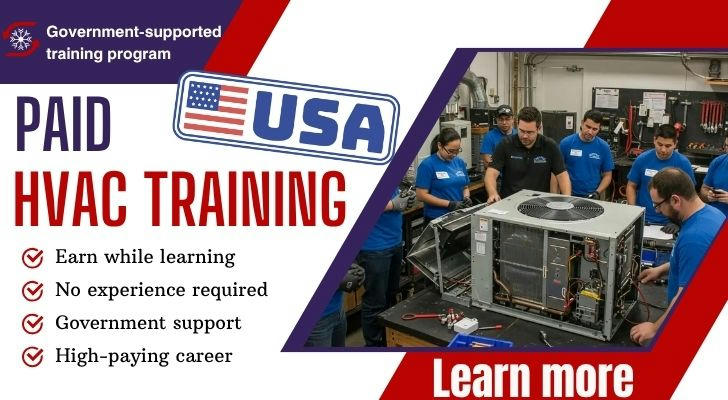Government-supported HVAC training programs—no experience required + earn while learning!
In this era of shortage of technical talents and fierce competition for employment, many people are looking for an opportunity that does not rely on academic qualifications or experience, but can quickly get a job and get a high salary. HVAC (heating, ventilation and air conditioning) industry is such a "low threshold, high return" golden track! Now, many states in the United States have launched government-supported HVAC training programs-No experience is required, you can learn and get paid! Whether you want to change careers, increase your income, or find a truly "promising" technical job, this is a springboard you can't miss!

Why choose a government-supported HVAC training program?
- No experience required, low threshold
No college degree or relevant technical experience is required, suitable for all kinds of groups such as fresh graduates, unemployed people, and career changers.
- Training costs are supported by government subsidies
Most projects are supported by federal or state government grants, and participants can obtain training materials, tool kits, certification exam qualifications, etc.
- Learn while earning, relieve financial pressure
During the training period, trainees can usually receive subsidies or internship wages ranging from $15-$25 per hour to relieve life pressure.
- Short training cycle, fast on-the-job speed
It ranges from a few weeks to a few months. Some projects can be directly recommended for employment after 6-12 weeks.
- Long-term employment security, good employment prospects
HVAC is a high-demand industry. With the renewal of aging equipment and the promotion of green energy technology, the job growth rate is expected to exceed 6% in the next 10 years, and the average annual salary is as high as $50,000-$70,000.
HVAC technician salary breakdown: income comparison table for different experience levels
| Experience level | Average hourly wage | Annual salary estimate (based on 2080 hours per year) | Job description |
|---|---|---|---|
| Entry-level / Newbie (0-1 year) | $18 - $24 | $37,000 - $50,000 | Apprentice, just completed training courses, need to work under the guidance of a master |
| Entry-level technician (1-3 years) | $22 - $28 | $45,000 - $58,000 | Can complete some maintenance tasks independently, with basic certifications such as EPA |
| Intermediate technician (3-5 years) | $28 - $35 | $58,000 - $73,000 | Independently complete system installation and troubleshooting, some people can guide beginners |
| Senior technician (5-10 years) | $35 - $45 | $73,000 - $93,000 | Proficient in multiple systems, with advanced certifications, can serve as field supervisor |
| Director/Management (10 years+) | $45 - $60+ | $93,000 - $125,000+ | Team leader, project manager, or self-contracted engineering business |
📌 Note:
Salaries in some areas (such as California, New York, Texas, etc.) may be higher than the national average, with additional overtime and travel allowances.
Obtaining additional certifications (such as NATE, OSHA, refrigeration licenses) will also increase wages.
Practitioners entering the commercial/industrial HVAC field usually earn more than residential technicians.
Who can sign up?
The following groups are particularly suitable for applying for HVAC government training programs:
Young people who want to quickly enter the technical industry;
Low-income people who are receiving unemployment benefits or SNAP benefits;
Blue-collar professionals who want to have stable jobs with room for advancement;
Those who are interested in obtaining technical certifications (EPA 608, NATE, OSHA 10, etc.);
Veterans who have retired from the military and want a smooth transition to civilian work.
What does the training include?
Government-supported HVAC courses usually cover the following modules:
- Basic electrical knowledge and safety regulations
- Refrigeration cycle and air conditioning principles
- Heating system installation and maintenance
- Ventilation and air quality control
- System fault diagnosis and repair skills
- Environmental regulations and refrigerant management (EPA 608 certification preparation)
- Practical simulation + master-led internship
Recommend several popular projects
The following are currently popular HVAC government-supported projects:
1. Workforce Innovation & Opportunity Act (WIOA) Project
Targeted at unemployed or low-income people;
Can subsidize HVAC training course fees;
Includes job search support services.
2. Job Corps vocational training
Targeted at youth aged 16-24;
Provide accommodation, meals, living allowances and HVAC skills training;
Recommend employment after graduation.
3. Veterans Affairs Skills Retraining Grant (VRRAP)
For veterans;
Provides tuition and living allowances for HVAC skills courses.
4. Community college + union cooperation program
Provides night or weekend classes;
Can study while working;
Some programs provide apprenticeship subsidies + union certificates.
How to sign up?
Contact the local employment service center (American Job Center) Get the latest training programs and open places.
Search for "HVAC technician training" on the government vocational training platform
Contact the local community college or technical school directly Ask if there are government-funded programs.
Visit the official website of the HVAC company or LinkedIn page Many large HVAC companies offer paid apprenticeship programs within the company.
Conclusion
Whether you are a young person who has just graduated or an adult on the road to transition, the HVAC industry is a promising, stable and high-paying career path. Government-supported training programs break down the barriers to entry in the technical industry, **so you no longer have to worry about tuition fees or experience. **
